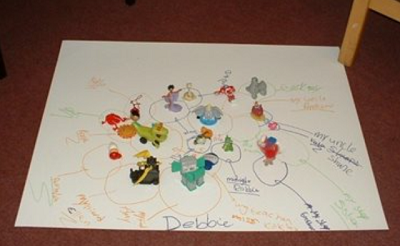
For use with: parents/carers, children aged 5-15, young people aged 16-18
What is a sculpting?
Sculpting uses objects such as small toys to help build a visual representation of a family and the network of people around the child. It is similar to an Ecomap and is a creative way of exploring family relationships and dynamics and can be used with children from a young age through to adults. It can be effectively used with individuals or a sibling group.

This is an example of a 10 year old girls sculpt (Baxter, A. (2003) Creative therapies with traumatised children. Jessica Kingsley Publishers, London).
When would you use it?
Sculpting can help you to understand the context in which families live. It helps you to:
- Create a visual representation of the present family system as seen by the child and family
- Explore with the child or family member who they feel emotionally close to and establish the value they place on their relationships
- Learn something about the child or family members sense of self and how they view others by what objects they choose to represent them
- Learn about people you may have not been aware of but who are important to the child or family member (Wrench, K. (2018) Creative ideas for assessing vulnerable children and families. Jessica Kingsley Publishers, London).
How would you use it?
Before starting it is important to talk about what will happen to the sculpt at the end. Are you going to copy it, take it away, and use it for assessment purposes? The person you are working with needs to know this so they can make a choice about what to share.
1. Encourage the person to think about who they would want represented – don’t forget things like pets which maybe a great source of comfort for a child. Tell them to think widely, including people they like and who are supportive, and people that they may struggle to get along with.
2. Help the person to place the object they have chosen to represent themselves on to a large piece of paper. Ask them to place other objects which represent the people (and pets) within their lives, positioning them near or far depending on their relationship. When working with children, place objects that they can use around the room to keep the session interactive rather than having them sit in one place.
3. Name the others around them, at the same time think about how close they are to each individual, for example,
- a supportive carer may be right next to the child,
- a violent person may be placed far away, or in fact the child may choose to still place them close to them even though this may not ‘fit’ with your view of a person.
It's important to go with what the person brings and gently enquire as opposed to interrogate. You are trying to get a snapshot picture of the person's feelings/thoughts about significant people.
4. As you are doing the exercise think about questions you may ask. Generally this exercise has a life of its own and questions/reflections come naturally. You may ask questions like:
"I notice that you have put mum very close to you. What do they do that makes them so close to you?"
"What makes this person so far away?"
"Have they ever been closer?"
"What would need to happen for them to come closer?"
5. When the sculpt looks complete to the person you are working with you may like to take a picture of it if you are able to do this appropriately. At the least, you should have a piece of paper with a note of where the various people are in relation to each other and any other notes that have been made. This record is useful to refer to in any on-going work and of course sculpts can change. Creating a further sculpt at a later date may show some difference in a person’s perceptions, or reflect changes in a child’s development, or progress in family dynamics which could be very useful for the participant to see.
6. It is important not to overtly interpret the sculpt as it represents what the person has chosen to share/create at that moment in time, although it is likely to demonstrate the main support that the child or family member has in their life. You can comment on the process of the exercise and on what you can see, but be careful about suggesting what it might mean. For example:
“You seemed to find that quite hard to start but then it got easier…”
“I notice that you have put mum really close to you but that your dad is right across the other side – do you want to say anything about that?”
7. Before ending the session, check in with the participant. Do you need to follow up anything, how do they feel about ending the session/what they have created? Check out who they can talk to about anything that comes up for them outside the session.
